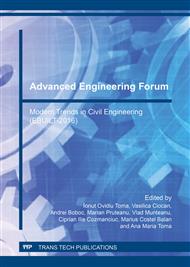p.37
p.45
p.50
p.58
p.65
p.73
p.78
p.86
p.94
Specific Behavior of Circular Metal Silo
Abstract:
In the current economic climate, agriculture has started to become one of the main areas of economic activity, including economically powerful states. One of the main problems in this industry is lack of storage space and maintaining quality of grain. Storing grain in silo structures ensure their high quality, efficient protection against the factors that lead to damage and allows keeping all season long and against climatic factors. Take into account the demands of modern agriculture productivity and high efficiency, silos have such an important economic role in the industry. The silos are in the top of industrial equipment that might experience during the lifetime cycle structural failure. Among the causes of structural failure it might be also the effect of seismic action. The silos located in seismic areas are exposed to extreme seismic loads. This paper presents the FE analysis results of the behavior of a circular metal silos located in seismic areas, taking into account the interaction of the granular material stored with the silo wall. The simulation of the contact surfaces of granular material and silo wall have been done based on Drucker - Prager model, available in ANSYS software vs.1.5. Influences of granular material characteristics stored up shall be also investigated and the results are highlighted in this paper.
Info:
Periodical:
Pages:
65-72
Citation:
Online since:
March 2017
Authors:
Price:
Сopyright:
© 2017 Trans Tech Publications Ltd. All Rights Reserved
Share:
Citation:


